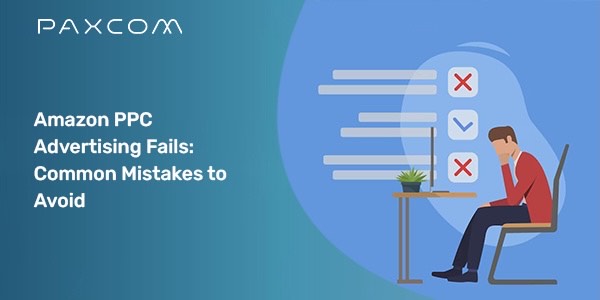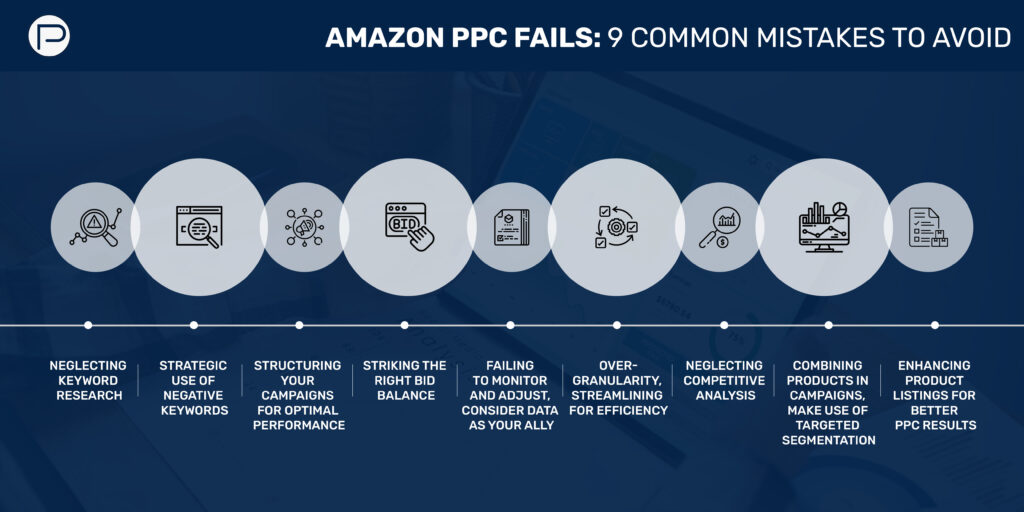Are your PPC campaigns failing to deliver the results you expected? Don’t worry; you’re not alone. Many sellers need help with their Amazon Pay-Per-Click advertising efforts, often due to common mistakes that can be easily rectified. This blog will explore the most prevalent Amazon PPC advertising fails and provide actionable tips to avoid them.
Table of Contents
Importance of Amazon PPC
Amazon PPC is a versatile marketing technique, and if initiated appropriately, it can do wonders for your business and help you gain a competitive edge. PPC is important; however, if not tested out properly, it could affect your sales and brand image in your niche. The fee is minimal and gets balanced out if the conversions are there. A correctly placed ad gives you a more significant chunk of profit than an incorrect one.
To ensure you don’t get the strategy wrong, we are here to help you with it. Our Amazon ADvisors experts are well-versed in campaign management and advertising.
Amazon PPC advertising fails: Common mistakes to avoid
- Neglecting keyword research:
Comprehensive keyword research is one of the fundamental pillars of a successful Amazon PPC campaign. Identifying and targeting the right keywords can lead to wasted ad spend and poor performance. To avoid this pitfall, utilize Amazon’s keyword research tools, such as Seller Central’s search term reports and Amazon’s Auto Campaign, to identify relevant and high-converting keywords for your product.
Diving into third-party platforms provides valuable insights into competitor keywords and trending search terms. Using these tools, you can better understand customer search behavior, discover long-tail keywords, and optimize your campaigns accordingly.
- Strategic Use of Negative Keywords
While negative keywords can work wonders in filtering out irrelevant traffic, there’s a danger in over-isolating your campaigns. Excessive negation might inadvertently restrict the reach of your ads and limit potential conversions. Striking the right balance is key to optimizing your campaigns for success.
- Structuring Your Campaigns for Optimal Performance
Organizing your PPC campaigns into well-structured and segmented ad groups can significantly impact their success. Creating separate ad groups for different product variations or categories allows you to control your bids and budgets better. This segmentation enables you to tailor your ad copy and target specific keywords, improving the relevance of your ads and increasing click-through rates.
Consider breaking down your campaigns into three levels: broad match, phrase match, and exact match. Doing so allows you to manage bids more efficiently and measure the performance of different keyword variations.
Unclear campaign names lead to confusion and hinder effective PPC management. Learn how to organize campaigns with clear and descriptive names, streamlining your tracking and optimization process.
- Striking the Right Bid Balance
Bidding too low or too high can hinder the success of your PPC campaigns. If you bid too low, your ads may not receive enough visibility, resulting in poor performance. On the other hand, excessively high bids can quickly drain your budget without delivering the desired returns.
To find the right bidding strategy, regularly review your campaign’s performance metrics, including click-through rates (CTR), conversion rates, and Advertising Cost of Sale (ACoS). Use Amazon’s Bid+ feature selectively to increase bids on keywords that are likely to convert automatically.
Implement an incremental bidding approach, starting with competitive but reasonable bids, and adjust them based on performance data. Strike a balance between maintaining visibility and profitability, and don’t hesitate to fine-tune your bids regularly.
- Failing to Monitor and Adjust, Consider Data as Your Ally
Launching a PPC campaign is just the beginning; continuous monitoring and optimization are essential for success. Track your campaign’s performance regularly and use data to make informed decisions. Keep a close eye on key metrics such as impressions, clicks, conversions, ACoS, and return on ad spend (ROAS).
ACoS Formula = Ad Spend ÷ Ad Revenue * 100
Analyze which keywords and ad groups drive the most sales and which are underperforming. Allocate your budget strategically based on performance and shift resources to top-performing keywords and products. Stay agile in your approach, test new strategies, and adapt to market trends and changes in customer behavior.
- Over-Granularity, Streamlining for Efficiency
While meticulous attention to detail is commendable, excessive over-granularity in your campaigns can lead to unnecessary complexity and hinder campaign management.
Discover the balance between granularity and efficiency, simplifying your campaigns without sacrificing relevancy. Learn how to consolidate similar products or keywords into manageable groups, streamlining your PPC operations and enabling you to focus on strategic growth.
- Neglecting competitive analysis
Keep an eye on your competitors’ strategies and performance. Analyze their ad copy, pricing, promotions, and overall market positioning. Understanding the competitive landscape can help you identify opportunities and make informed decisions for your campaigns.
On Amazon, the competitive landscape is ever-changing. Ignoring your competitors’ strategies can put you at a significant disadvantage. Regularly analyze your competitors’ campaigns and tactics to stay ahead of the game.
Use digital shelf analytics tools to gain insights into competitor keywords, pricing, and promotions. Identify gaps in their strategies and capitalize on opportunities to differentiate your products and stand out in the marketplace.
By avoiding these common mistakes and adopting best practices, you can increase the effectiveness of your Amazon PPC advertising campaigns and drive better results for your business.
- Combining products in campaigns, Making use of targeted segmentation
Mixing products in campaigns, where different products with varying characteristics are combined in the same ad group or campaign, can lead to bid management challenges, ad relevance issues, and difficulties in performance reporting. To overcome these pitfalls, embrace targeted segmentation by assigning each product to its dedicated ad group or campaign. This allows for fine-tuning bids, tailoring ad copy, and increasing relevancy, leading to higher conversions and a better ROI for your Amazon PPC advertising efforts.
- Enhancing Product Listings for Better PPC Results
Your product listing quality directly impacts the effectiveness of your PPC campaigns. If your listings lack compelling images, informative bullet points, and relevant product descriptions, your ads may not attract enough clicks. Prioritize optimizing your product listings to ensure they align with your PPC campaigns and draw in potential customers.
Make sure your product titles are clear, descriptive, and include relevant keywords. Utilize high-quality images and compelling product descriptions to showcase the unique selling points of your products. Additionally, leverage Enhanced Brand Content (EBC) or A+ Content to provide customers with an enhanced shopping experience and further boost conversion rates.

Your ad copy also plays a crucial role in attracting potential customers. Avoid generic or unclear messaging, and make sure to highlight the unique selling points of your product. Use compelling CTAs to encourage clicks and conversions.
Maximize Your Potential With Paxcom
At Paxcom, we offer end-to-end campaign management services in sync with the brand’s objectives. The campaigns are managed by our advertising experts, who are AMS certified and supported by Paxcom’s eAdvertising360 software, and we manage multi-million spends across different platforms and categories across multiple platforms and geographies.
Discover how Paxcom drove 1.5x impressions for a home improvement brand with our 360-degree campaign approach by creating a tailor-made strategy to target potential customers. As a result, the brand experienced a surge in impressions and recorded 1.3x growth in orders.
Would you like to witness such growth for your brand as well? Fill out the form, or feel free to reach out to us at info@paxcom.net for more information.















